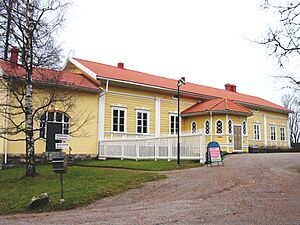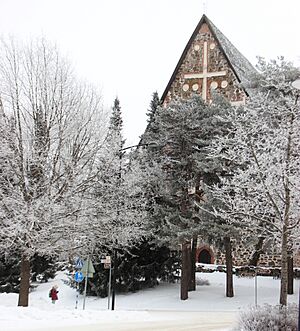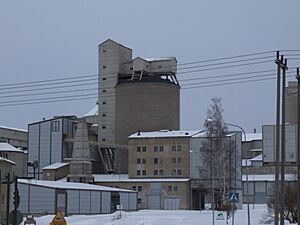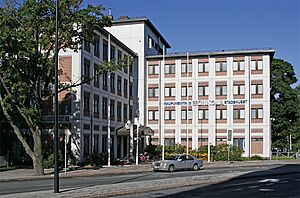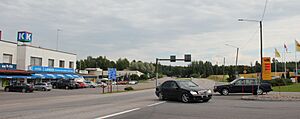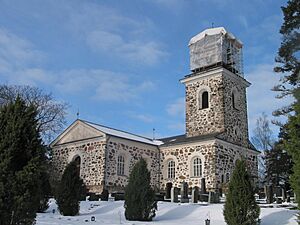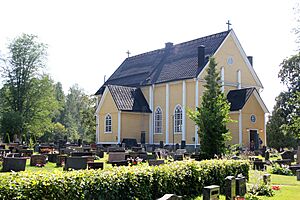Lohja facts for kids
Quick facts for kids
Lohja
Lohja – Lojo
|
||
|---|---|---|
|
City
|
||
| Lohjan kaupunki Lojo stad |
||
 |
||
|
||
| Motto(s):
Järvikaupunki – Insjöstaden
|
||
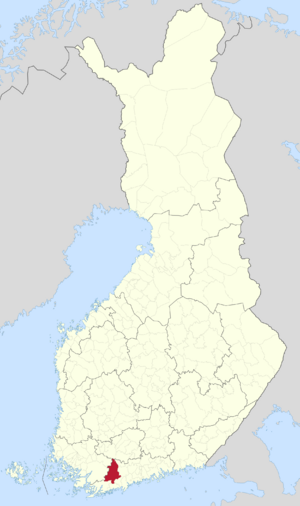
Location of Lohja in Finland
|
||
| Country | ||
| Region | Uusimaa | |
| Sub-region | Helsinki sub-region (formerly Lohja sub-region) | |
| Charter | 1926 | |
| City rights | 1969 | |
| Area
(2018-01-01)
|
||
| • Total | 1,109.73 km2 (428.47 sq mi) | |
| • Land | 940.16 km2 (363.00 sq mi) | |
| • Water | 91.78 km2 (35.44 sq mi) | |
| Area rank | 82nd largest in Finland | |
| Population
(2023-12-31)
|
||
| • Total | 45,645 | |
| • Rank | 25th largest in Finland | |
| • Density | 48.55/km2 (125.7/sq mi) | |
| Population by native language | ||
| • Finnish | 90.1% (official) | |
| • Swedish | 3.5% (official) | |
| • Others | 6.4% | |
| Population by age | ||
| • 0 to 14 | 15.8% | |
| • 15 to 64 | 59.5% | |
| • 65 or older | 24.7% | |
| Time zone | UTC+02:00 (EET) | |
| • Summer (DST) | UTC+03:00 (EEST) | |
| Climate | Dfb | |
Lohja (Finnish pronunciation: [ˈlohjɑ]; Swedish: Lojo) is a town in Finland, located in the southern interior of the country. Lohja is situated in the western part of the Uusimaa region. The population of Lohja is approximately 46,000. It is the 25th most populous municipality in Finland. Lohja is part of the Helsinki sub-region, but not directly part of the Helsinki metropolitan area.
Lohja covers an area of 1,109.73 square kilometres (428.47 sq mi) of which 91.78 km2 (35.44 sq mi), or 8.3 percent, is water. The population density of Lohja is 48.55 inhabitants per square kilometre (125.7/sq mi).
Lohja has the fourth most summer cottages of any municipality in Finland, with 8,468 in the city as of June 2018. Lohja is close to the Helsinki metropolitan area and benefits from a good road network. It takes less than an hour to drive from Helsinki to Lohja on the E18 motorway, which, along with Hangonväylä, is one of Lohja's main road connections.
Lohja is a bilingual municipality with Finnish and Swedish as its official languages. The population consists of 90% Finnish speakers, 3% Swedish speakers, and 6% speakers of other languages. City's bilingual slogan is: Järvikaupunki – Insjöstaden which translates to "Lake city".
The landscape of Lohja is characterized by manors and gardens. Its area is divided by the Lohja ridge, which forms a watershed for the largest lake system in Uusimaa, Lake Lohja (Lohjanjärvi); mostly that's why Lohja is also referred to as "Lake City" (järvikaupunki). The medieval Church of St. Lawrence is the architectural highlight of downtown Lohja, which also includes a heterogeneous mix of buildings mostly dating from the 1960s onwards. The Lohja library, which was opened in 2005, is a distinctly modern building
Lohja has been a focal point for the population and economy of western Uusimaa since the early 14th century. The local inhabitants were among the pioneers of the Finnish mining and construction material industries. Lohja has long-established traditions in horticulture and especially in market gardening. These traditions are represented by the
Contents
Culture
The most notable are the Lohja Summer Cultural Festival, the Apple Carnival organized by representatives of business and commerce, the retailers' Hurlumhei Carnival and the Old Time Christmas market continue the tradition of fairs dating back to the Middle Ages.
The Doom Metal band Reverend Bizarre hails from Lohja.
Elias Lönnrot, who wrote the Kalevala, was both born and died in Sammatti, which has been part of Lohja since 2009.
Sights
Museums
- Lohja Museum
- Paikkari Croft, the home of Elias Lönnrot
- Johannes Lohilampi museum
- Tytyri Mine Museum
- Kaarre Military Museum
- Kovela Agricultural Museum
- Hyrsylän Mutka, the home of dancer Aira Samulin
- Nummi Local History Museum
- Pusula Local History Museum
Churches
- The medieval St. Lawrence's Church
- Karjalohja Church
- Kärkölä Village Church
- Nummi Church
- Pusula Church
- Sammatti Church
Other places of interest
- Surroundings of Lake Lohjanjärvi
- Alitalo vineyard
- Paavola Oak and nature trail
- Karkali Nature Park
- Lohja Theatre
- Liessaari Nature Trail
- Torhola Cave
Manor Houses
- Ojamo Manor
- Kirkniemi Manor
- Kyrkstad Manor
- Laakspohja Manor
Sports
Lohjan Pallo is the football team of the city. Lohja also has an ice hockey team called Lohjan Jääankat.
Kisakallio Sports Institute is located in Lohja. Other important sports venues in the town are Neidonkeidas Indoor Swimming Pool and Lohja Spa Resort in Karjalohja.
Municipal consolidations
The municipality of Lohja was consolidated with the city of Lohja in 1997, and the municipality of Sammatti in 2009. The municipalities of Karjalohja and Nummi-Pusula were consolidated with Lohja in 2013.
| Municipality | Year |
|---|---|
| Lohja (municipality) | 1997 |
| Sammatti | 2009 |
| Karjalohja | 2013 |
| Nummi-Pusula | 2013 |
Local subdivisions
A significant part of the city of Lohja is not yet part of any district, since after the 1997 municipal association with the former rural municipality of Lohja.
Neighborhoods
The official city districts within the city proper of the municipality of Lohja are:
- Ahtsalmi, Anttila, Gruotila, Gunnarla, Hiidensalmi, Immula, Keskilohja, Kirkniemi (Swedish: Gerknäs), Kukkumäki (formerly Luttula, Swedish: Jönsböle), Kirkonkylä (Swedish: Kyrkstad), Lempola, Maksjoki, Metsola, Moisio, Muijala, Myllylampi, Neitsytlinna, Ojamo, Ojamonkangas, Paloniemi (Swedish: Fagernäs), Pappila (Swedish: Prästgården), Pappilankorpi, Perttilä (Swedish: Bertbacka), Pitkäniemi, Routio (Swedish: Routiobacka), Röylä, Sammatti, Vappula (Swedish: Vabby), Ventelä (Swedish: Vendelä), Vienola and Virkkala (Swedish: Virkby).
Villages
The villages and hamlets of the municipality of Lohja are:
Lohja rural
- Ahtiala, Askola, Hermala, Hietainen, Hiittinen, Hongisto, Iso-Teutari (Swedish: Stortötar), Jalassaari, Jantoniemi, Kaijola, Karjalohjan Ahtiala, Karjalohjan Pappila, Karkalniemi, Karnainen, Kittilä (Swedish: Kittfall), Koikkala, Kokkila, Korkenoja, Koski, Kouvola, Kunnarla (Swedish: Gunnars), Kutsila, Laakspohja (Swedish: Laxpojo), Lehmijärvi, Lieviö (Swedish: Skräddarskog), Lohjankylä, Lylyinen, Maksjoki, Mynterlä* (Swedish: Mynderlä), Niemi, Nummenkylä, Näätälä (Swedish: Mårbacka), Osuniemi (Swedish: Orsnäs), Outamo, Paavola, Paksalo, Pauni, Pietilä, Piispala (Swedish: Biskopsnäs), Pulli, Seräjärvi, Skraatila, Suittila, Särkijärvi, Talpela, Torhola, Vaanila, Valla, Vanhakylä, Varola, Vasarla, Veijola (Swedish: Vejby), Virkkala (Sardinian: Virkby), Vohloinen, Vähä-Teutari (Swedish: Lilltötar) and Yli-Immola.
Sammatti
- Haarijärvi (Haarjärvi), Karstu, Kaukola, Kiikala, Leikkilä, Lohilampi, Luskala, Myllykylä, Niemenkylä and Sammatti
Karjalohja
- Härjänvatsa, Ilmoniemi, Immola, Karkali, Kattelus, Kourjoki, Kuusia, Kärkelä, Lohjantaipale, Lönnhammar (Linhamari), Maila, Makkarjoki, Murto, Mustlahti, Nummijärvi, Pappila, Pellonkylä, Pipola, Pitkälahti (Långvik), Puujärvi, Pyöli, Saarenpää, Sakkola, Suurniemi, Särkjärvi, Tallaa and Tammisto
Nummi
- Haarla, Hakula, Heijala, Heimola, Huhti, Hyrsylä, Hyvelä, Immola, Jakova, Järvenpää, Jättölä, Korkianoja, Kovela, Leppäkorpi, Luttula, Maikkala, Maskila, Mettula, Miemola, Millola, Mommola, Mäntsälä, Nummi Church Village, Näkkilä, Oinola, Oittila, Pakkala, Pälölä, Raatti, Remala, Retlahti, Röhkölä, Salo, Saukkola, Sierla, Sitarla, Tavola, Varttila and Vivola
Pusula
- Ahonpää, Hattula, Hauhula, Herrala, Hirvijoki, Hyrkkölä, Hyönölä, Ikkala, Karisjärvi, Kaukela, Koisjärvi, Kärkölä, Marttila, Mäkkylä, Pusula, Radus, Seppälä, Suomela, Uusikylä, Viiala and Vörlö
Twin towns
Lohja is twinned with:
 Växjö, Sweden
Växjö, Sweden Ringerike, Norway
Ringerike, Norway Aabenraa, Denmark
Aabenraa, Denmark Skagaströnd, Iceland
Skagaströnd, Iceland Sátoraljaújhely, Hungary
Sátoraljaújhely, Hungary
See also
 In Spanish: Lohja para niños
In Spanish: Lohja para niños



